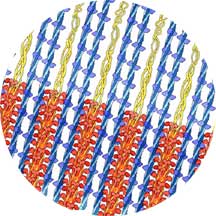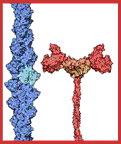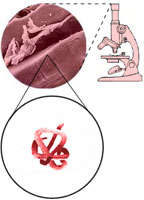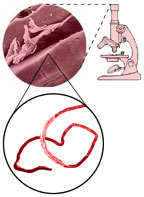|
|
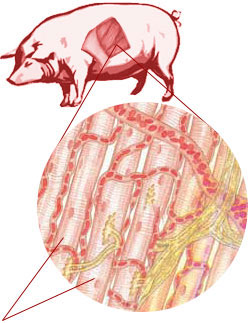
muscle
fibers, or cells
|
|
|

Meat
is mostly the muscle tissue of an animal. Most animal
muscle is roughly 75% water, 20% protein, and 5% fat,
carbohydrates, and assorted proteins. Muscles are made
of bundles of cells called
fibers.
Each
cell is crammed with filaments made of two proteins:
actin and myosin.
|
|
|
|
|
actin
myosin
|

|
|
|
In
a live animal, these protein filaments make muscles contract
and relax. Both actions require enormous amounts of energy,
which they get from the energy-carrying molecule ATP (adenosine
triphosphate). The most efficient generation of ATP requires
oxygen, which muscles get from circulating blood.
|
|
|
|
|
|
ATP
powers muscle contraction.
|
|
-
-
-
- - - - - - -
- - - - - - - -
- - - - - - - - - - - - - -
-
- - - -

|
After
an animal is slaughtered, blood circulation stops, and muscles
exhaust their oxygen supply. Muscle can no longer use oxygen
to generate ATP and turn to
anaerobic glycolysis,
a
process that breaks down sugar without oxygen, to generate
ATP from glycogen, a sugar stored in muscle.
The
breakdown of glycogen produces enough energy to contract the
muscles, and also produces lactic acid. With no blood flow
to carry the lactic acid away, the acid builds up in the muscle
tissue. If the acid content is too high, the meat loses its
water-binding ability and becomes pale and watery. If the
acid is too low, the meat will be tough and dry.
Lactic
acid buildup also releases calcium, which causes muscle contraction.
As glycogen supplies are depleted, ATP regeneration stops,
and the actin and myosin remain locked in a permanent contraction
called
rigor mortis.
Freezing the carcass too soon
after death keeps the proteins all bunched together, resulting
in very tough meat. Aging allows enzymes in the muscle cells
to break down the overlapping proteins, which makes the meat
tender.
|
|
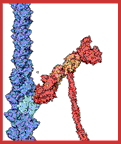
Without ATP, actin and myosin remain locked
in a permanent contraction called
rigor mortis.
|
-
- - - - - - - - - - - - - - - -
- - - - - - - - - - - - - -
-
- - - - -

|
|
|
|
|
|
|
|
|
Beef
muscle fibers with blowup of a coiled protein, before
cooking
|
|
An
uncoiled, or
denatured,
protein, after cooking
|
|
Individual
protein molecules in raw meat are wound-up in coils, which are
formed and held together by bonds. When meat is heated, the
bonds break and the protein molecule unwinds. Heat also shrinks
the muscle fibers both in diameter and in length as water is
squeezed out and the protein molecules recombine, or
coagulate.
Because the natural structure of the protein changes, this process
of breaking, unwinding, and coagulating is called
denaturing.
|
Cell
illustrations By David Goodsell
Micrograph images courtesy Nutrition and Food Management, Oregon
State University
|


